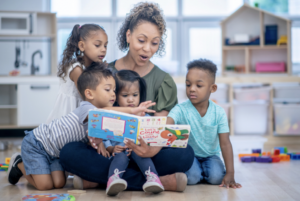Sound Play
Sound play is a great way to encourage development of speech sounds. Animal and environmental sounds are a great way to involve your child. Animal sounds are primarily composed of consonant and vowel combinations, (ex. “Moo, baa, neigh”) and are great ways to practice combining sounds. Adding environmental sounds/sound effects to different objects/actions is great too!
For example, a car can go “vroom vroom” or “beep beep”, a telephone can “ring ring”, or if someone is quiet or sleeping, we can say “shh shh”.

Nouns
Picture books are an easy way to label different objects. The pictures in the books also provide meaning to words. During reading, caregivers are able to point to items/objects and label them. Encourage children to also point and bring your attention to different pictures. Encourage your child to label the picture or imitate your model. Additionally, repeat new vocabulary words multiple times! Repetition is important for retention and understanding of the new words.
Verbs
Verbs are action words and are a stepping stone to making longer utterances! Label the actions of the characters in the picture books. Additionally, you can model the actual action to provide real life meaning.
For example, point to a picture and say “the bear is sleeping”, and then model pretend sleeping. Providing verbs help our children increase their use of 2-3 word phrases as they learn early sentence structure.

Adjectives
Adjectives are words used to describe objects and are also a stepping stone to making longer utterances! Picture books are colorful with lots of detail. While pointing to different pictures, you can add descriptive words such as color, size, shape.
For example, you can point to a dog and label, “dog”, but you can also add “the black dog,” and “he has a long tail”, etc.
Prepositions
Prepositions help tell direction, time, place, location, and spatial relationships. Picture books provide multiple models of prepositions and often have a corresponding example. When labeling objects on a page, you can also highlight the preposition.
For example, “the dog is on the chair” or “he is sleeping at night.”

Object/Function Association
It is easy to label objects and talk about the different ways we use them. For example, “ fork – that is used for eating” or “bed – we sleep in a bed”. Creating object/function associations provide children with understanding and meaning of the words.
If you would like a more in-depth discussion and demonstrations of how to use picture books to build language skills, check out or Youtube video! Watch Now!
Blog post written by Natalie Radford, MS, CCC-SLP

0 Comments